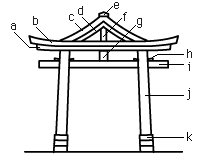| Also
called hie torii ϊgΉ, sougou torii Ή, hafu torii jΉ
or gasshou torii ΆΉ. A wooden entrance gate at a Shinto shrine *torii
Ή, characterized by a gable shaped structure composed of a central strut and
diagonal braces on each side and placed on top of the uppermost lintel *kasagi
}Ψ. At the peak of the gable is a very short member called a utou Gͺ,
torikabuto Ή or which karasugashira Gͺ suggests a ridge. These
architectural elements have no structural significance but may symbolize a mountain
deity. Two characters may also be hidden within its bargeboard-like gable shape.
If the upper ends of the peak were to be turned to an upright position, the character
for mountain, yama/san R would be discernible. If the same members
were raised to a horizontal position the character for king, ou € would
be represented. Thus, the connotation of a mountain king could be extended to
mean a mountain deity. It is from these hidden characters that the name,
sannou R€ is derived. Furthermore, sannou torii is located at the foot
of Mt. Hiei δb. Example: Hie Taisha ϊgεΠ, both the East and West
areas, Shiga prefecture. |



